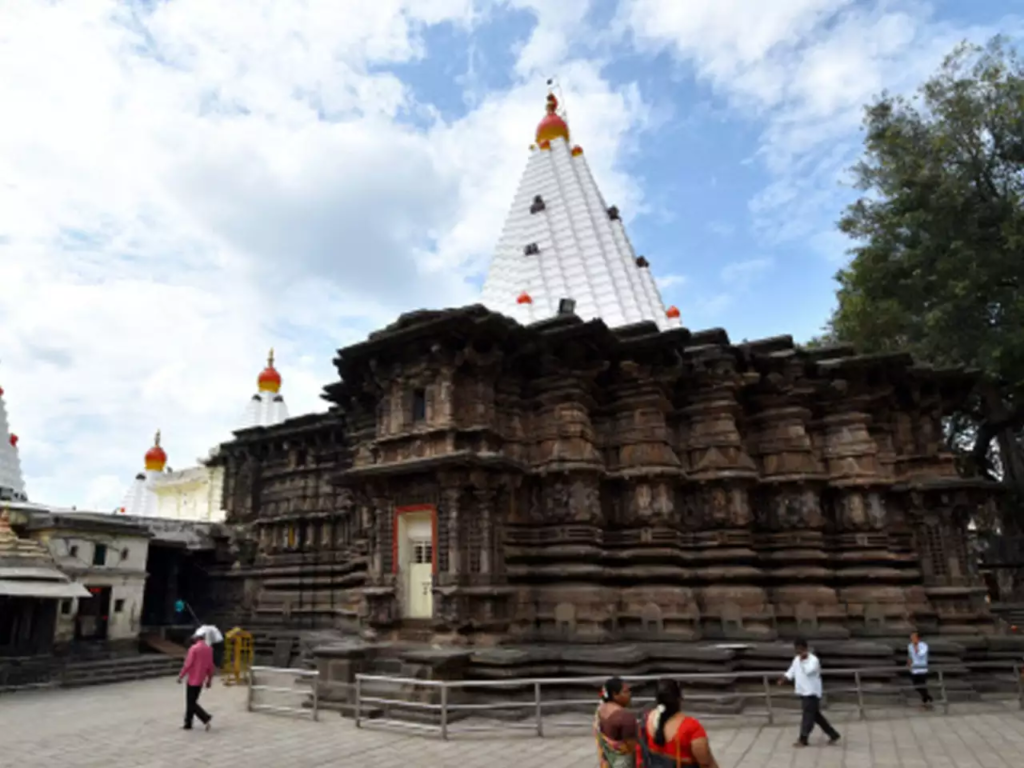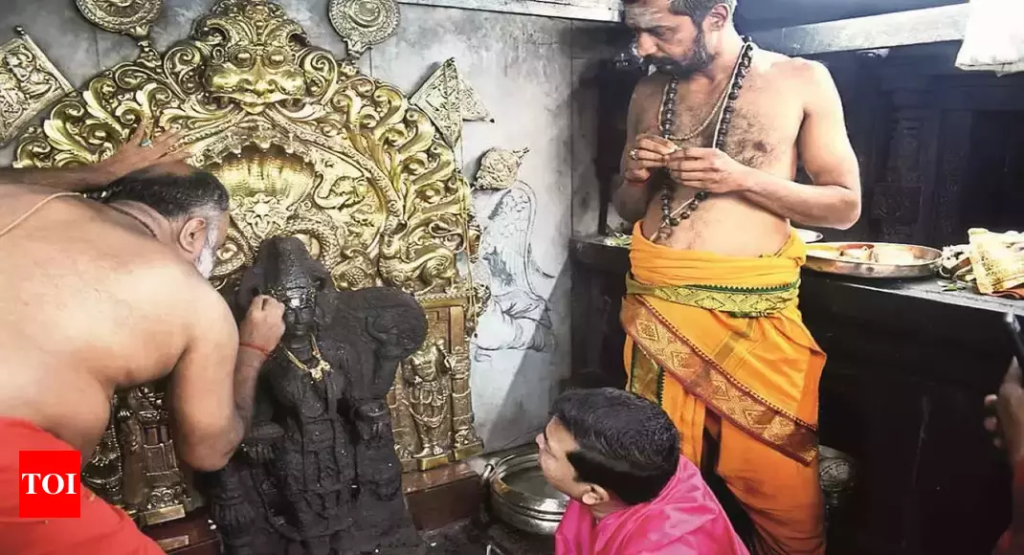
Kolhapur, the ancient city situated on the banks of Panchganga river in south Maharashtra, is visited by lakhs of devotees every year. Its historic significance can be traced back to the 1st century BC and continues to amaze visitors with its intricate carvings and magnificent temples. Kolhapur is known as ‘Dakshin Kashi’ or Kashi of the South because of its spiritual history and the antiquity of its shrine Mahalaxmi, better known as Ambabai.
There is a very interesting folklore about how this temple and Mahalakshmi came into existence. The sage named Bhrigu was traveling across universe. He visited Vaikunth, where Vishnu and Lakshmi were resting on the Shesh naga. Vishnu did not notice Bhrigu arriving, and did not welcome him. This anguished Bhrigu who kick Vishnu in his chest, close to his heart. Vishnu realising the anger of Bhrigu, apoligised to him and started pressing his legs as a way of respect. This act of apologising didn’t go down well with Lakshmi. The area near Vishnu’s heart belonged to Lakshmi, because she lived in Vishnu’s heart. So kicking Vishnu’s heart was just like kicking Lakshmi. Angry with Vishnu, Lakshmi left Vaikunth and came down on earth, to settle at Kolhapur. Vishnu came to earth, looking for Lakshmi. But he instead settled in Tirumala, marrying local princess Padmavati.
The story very beautifully connects the Vaishnav shrine in the south, with a Shakt shrine in the west. Interestingly, this story appears to be very popular these days. But it does not find any mention in any of the religious tects.

Image Courtesy : Times of India
The idol is in standing posture, with four hands. The goddess holds a mace (गदा), shield (ढाल / खेटक ), citurs fruit (महाळुंग) and a small pot (पानपात्र) in her hands. A lion can be seen sitting by her feet. The crown she wears has a snake like design carved on it.
The temple of the goddess Mahalakshmi was built by Karnadeva in 634 CE Chalukya reign. Mounted on a stone platform, the idol of the crowned goddess is made of gemstone. The image of Mahalakshmi carved in black stone is 3 feet in height. The Shri Yantra is carved on one of the walls in the temple. A stone lion (the vahana of the goddess), stands behind the statue.
Lately, there has been a discussion lately regarding whether Ambabai of Kolhapur is a manifestation of Shakti or Lakshmi. For us, this isn’t really a topic of debate. Any deity is equally sacred for us. But I would like to present a few points here.
1. The temple is considered to be one of the Shakti Peethas. Shakti Peethas are significant shrines and pilgrimage destinations in Shaktism. The shrines are dedicated to various forms of Adi Shakti.
The story, about how the Shaktipeethas came into existence, is mentioned in many Puranas. At an Yajnya organised by Sati’s father Daksha, Sati went uninvited. There she and her husband Shiva was insulted. Anguised with the insult, Sati entered the sarificial fire and gave away her life.
Enraged at the death of his spouse, Shiva, in his Virabhadra avatar, destroyed Daksha’s yajna and cut off his head. His anger not abated and immersed in grief, Shiva then picked up the remains of Sati’s body and performed the Tandava, the celestial dance of destruction, across all creation. Frightened, the other deities requested Vishnu to intervene to stop this destruction. As a recourse, Vishnu used the Sudarshana Chakra on Sati’s corpse. This caused various parts of Sati’s body to fall at several spots across the world. Every place, where Sati’s body parts fell, became one Shakti Peetha.
It is said that Sati’s eye fell at this place. So the place by default gets associated with Sati, which is a form of Shakti.
2. Always, there is a sacred animal associated with the goddess, usually placed in front of the sanctum sanctorum. If it is elephant, then the deity is Lakshmi; if it is the lion, the deity is Durga.
At the Kolhapur Mahalakshmi temple, we can see a lion in the Vahanmandapa just outside the Garbhagriha. There is also a lion sculpted with the idol of Ambabai. The lion sculpture here firmly establishes her as the goddess of power and war and royalty.
3. Every year, as part of the Navaratri and Dassera celebrations, the local martial Maratha clans sacrifice a goat for her pleasure, for she is considered to be ‘hot’ and ‘fierce’. The tradition may not be practised now, but there are multiple evidences about existence of this ritual in the past. The tradition of sacrifice existed as part of Shakt traditions, especially in the tribal areas. We see the animal sacrifice traditions in only the temples dedicated to either Shiva or Shakti in her various forms, and not in any of the temple dedicated to Vishnu or Lakshmi.
4. In her hands she holds a massive mace, a shield, a vessel and a citrus fruit, symbols not usually associated with Lakshmi. Lakshmi is the goddess of wealth, fortune, power, beauty, fertility and prosperity. So the symbols usually associated with Lakshmi could be lotus flower, water pitcher, pot with gold coins etc. However, some literature such as Lakshmi Sahastranama of Skanda Purana talks of Lakshmi holding weapons in her hand. But this representation of Lakshmi holding weapons is not very commonly seen in terms of iconography.
5. It is widely said that the central dome of Mahalaskhmi temple has a Shiva shrine as well. Even though the pilgrims are not allowed to visit the shrine, the official website of Temple management committee talks about this shrine. The shrine is over the sanctum sanctorum of Ambabai. This superstructure also hosts a shrine of Ganesha. The existence of Shiva and Ganesha shrine just above the sanctum sanctorum of Ambabai points towards the temple being a Shakti temple.
6. The name Amba is probably a corrupted form of Ambika. Mahabharata also has mention of sisters named Amba, Ambika and Ambalika. Ambika is another name of Shakti. Devi Mahatmya, a part of Markandeya Purana. The Devi Bhagavata Purana or Devi Mahatmya talks of Ambika as the lineal progenitor of all other goddesses. She is worshipped with many other forms and names such as Vhadrakali, Chandi, Mahakali, Navdurgas, Matrikas, Meenakshi, Kamakshi etc.
If we think of these pointers, the temple seems to be one associated with Shakti. Now one important question that arises is why it is called Mahalakshmi.
One important in event in Maharashtra history is when families of Chhatrapati Shivaji’s two sons got separated and formed two different branches of Maratha clan. Before that, the Tuljabhavani of Tuljapur (also one of the Shakti Pithas) was the family deity of Bhosales. After Chhatrapati Sambhaji’s son Shahu became the ruler of Satara and Tuljapur became part of Satara kingdom; the Tarabai family (widow of Chattrapati Raja ram and ruler of Kolhapur kingdom) had to find their own family deity. So they decided to go with the Gram-Devta of Kolhapur.
The idol of Ambabai was kept safe at the time, because of attackers from Adil Shahi of Bijapur and the Moghuls. This idol was found in a house in Kapila Teertha Market in the city. According to Chhatrapati Sambhaji’s letter dated 8 November 1723, Sindhoji Hindurao Ghorpade of Panhala installed the idol again on 26 September 1712 (Monday, Ashwin Vijaya Dashami). The idol was brought out of the safe place and installed it in the temple as Mahalakshmi. That’s how it started to be called as Mahalakshmi. And why was a Shakti idol established calling Mahalakshmi? The answer is in symbolism. You see, Marathas were fighting a lot of wars for long time. Chhatrapati Shivaji had created a kingdom from scratch. And had regained a lot of region from the Muslim invaders.
Now, after death of Chhatrapati Shivaji and his two sons, it was time for developing the kingdom that Chhatrapati Shivaji had created. So the need of the time was not the Warrior goddess Parvati / Shakti, but the prosperity goddess Lakshmi. The kingdom now needed Lakshmi more than Shakti. Maybe that’s why the temple was named Mahalakshmi. But the old name of Ambabai also prevailed.
